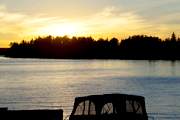 sunset over calm lake
sunset over calm lake
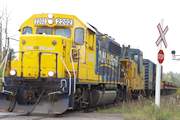 goods train hoots as it goes by
goods train hoots as it goes by
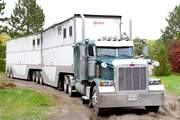 parked animal transporter
parked animal transporter
 maple leaves turning red
maple leaves turning red
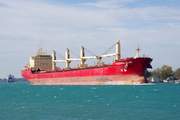 freighter on the St Clair River
freighter on the St Clair River
 harvesting soya beans
harvesting soya beans
 Amerindian sign 'watch out for snakes'
Amerindian sign 'watch out for snakes'
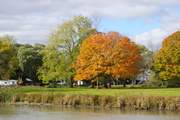 riverside autumn scene
riverside autumn scene
A visit to Ontario –
from and to Toronto
The summer at home had been long and hot; the chilliness and windiness of autumn in the province of Ontario was a shock to my system – I expect holidays to be warm! My idea was to visit four of the five North American 'Great Lakes' and get a feel for the enormity of Canada, which is, after all, rather larger than Europe. As it turned out I visited only a small part of this one province, although I managed to see some autumn colours as well as white-topped waves on those big sea-like lakes.
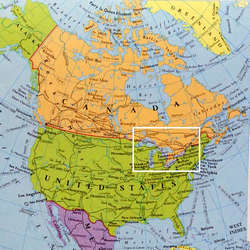
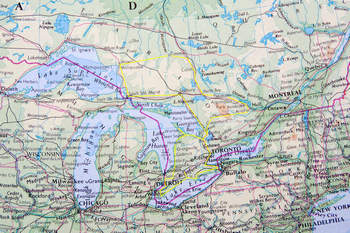 I visited only a small part of the Great Lakes, outlined in white on the left.
Click this map to enlarge it.
I visited only a small part of the Great Lakes, outlined in white on the left.
Click this map to enlarge it.
I found a flattish land with either immense fields (in the latter part of the trip) or unending forests with small dark lakes. The first part, once away from the Toronto conurbation, was grey-sky dull as I drove gently (speed limits are low) on straight or very slightly curving roads chiselled through the woods to give the impression of a vertical-sided trench (and me at the bottom, unable to see out). The occasional lake, blackly ringed by dark conifers under a dark sky, was glimpsed on left or right, not exciting enough to get me out of the car into the chilly breeze to take a photo.
However, the journey between Sudbury and Sault Ste. Marie gave glimpses of Lake Huron and changing views under a less leaden sky. In that town I strolled along the promenade to visit the Canadian lock which gives access to Lake Superior. Larger ships now go through the lock on the US side of the border – locks, where there used to be rapids, because there's a height difference of over 5m between Lakes Huron and Superior.
 photos of the first part of my journey
photos of the first part of my journey

Thence north to Wawa and across to Chapleau – I had already, after only several days, decided not to continue west round Lake Superior as I'd originally planned. Unfortunately the gigantic Provincial Park near Chapleau, where I had hoped to see big animals such as moose and black bear, was closed – season over. So I drove to silver-mining New Liskeard, north of North Bay, and stayed there a couple of nights on my way gradually south. There are fields and wheat silos nearby, so the scene was a little different from the woods I had been through up to then. Motel rooms have fridge and microwave included, so I soon learnt how to cook my morning coffee (no kettles provided) and unfreeze a 'family dinner'.
The trip often seemed rather boring and monotonous – none of the bustle and
bright colours of Morocco or Thailand, for instance.
The same trees millions of times over, the same dark lakes by the hundred,
the same motel rooms by the dozen
(in actual fact, they all differ, but the helpful service is essentially the same).
And the same grey cloud blocking out any sunshine that could warm my old bones
and give life to the autumn colours
(European ones can be just as pretty, but the Canadians advertise theirs better).
I went as far as the Quebec border one day (30kms from where I was staying)
but it snowed – why today?
But if I hadn't come to Canada I wouldn't have had this experience, would I?
 photos of the northern section
photos of the northern section

After two weeks of grey sky and temperatures between 4 and 10 degrees, my sunny days around the very big Algonquin Provincial Park started at 18 degrees and went up to 25 – a little hazy in the afternoon with a few wisps of cloud. Designated a "beautiful region", so there were plenty of tourists (especially Asian) and even coach trips to see the autumn colours. Better than before, but I'd have liked a height dimension - you can never see far because there are no real hills. Nor can you easily stop to take photos; the roadside band is a little too narrow for comfort. Villages (towns, they call them - Wawa has a population of 3700!) are spread-out centres of a few shops amongst scattered low houses, each in its own grassy patch.
 autumn photos of the Algonquin region
autumn photos of the Algonquin region

A few days in the Toronto conurbation and then I set off west again, finding a region that
pleased me more than elsewhere on my trip.
This was the Bruce peninsula that sticks up from Owen Sound to separate Georgian Bay from the main section of Lake Huron.
Here are a few limestone cliffs, perhaps 30 or 40m tall
that at least gave an elevated outlook over the forests and pasture land.
But then, my good impression could just have been because I found a motel cheaper than usual and a self-service laundry,
though the sun did shine nicely on the bright red leaves of the autumn maples.
 photos of the Bruce peninsula
photos of the Bruce peninsula

The wind came up, blowing mercilessly across Lake Huron (a lot wider than the English Channel to Dover) from the USA and creating some impressive waves. The houses were the low wooden clapboard houses you've probably seen on the TV, hidden away in wooded corners or delapidating ungracefully along the water's edge, rarely worth a second glance. But I had a good pub dinner at Kincardine, a pleasant village not far north of Goderich and carried on towards London (a declining city which has a Covent Garden market) and the northern coast of Lake Erie. On the way I visited the St. Clair River (the border with the USA) and Wallaceburg, where I asked the Canadian customs man if I could just go across and back on the ferry boat without a US visa; he said 'no' because everyone must disembark on the US side. The river is wider than the Rhine at Basle and the ships are much bigger.
At last I saw a wild animal bigger than a squirrel (they have black as well as grey squirrels here). It was a raccoon with a black face mask and ringed tail, roughly the size of a fox. At times the land seemed almost lifeless and I was rather disappointed by the birds; I had expected to see more but they had obviously flown off to warmer parts. I fumbled through the big field guide like a beginner as I'd forgotten the American bird families.
I had seen quite a few huge combine harvesters at work in the big fields on the very flat land here. One crop was maize; I had no problem recognising that. But the other crop, which at first I thought was a grain crop, turned out to be (after I'd found someone to ask) soya beans. I had never seen them growing before.
 photos of the south-west of my trip
photos of the south-west of my trip

On the road I was often caught out by the 4-way stops, even in quiet areas, and
the rarity of 'give way' (yield) signs. The roads tend to be wide (and
often increasingly wide, to cope with population growth). Europeans need
to adjust to the traffic lights at junctions, especially the 'right turn
on red'. Traffic near towns is concentrated as everyone uses a vehicle,
even to go to the plazas where the hangar-like shops are found.
Suburban roads are frequently tree-lined and parks everywhere.
I was surprised by the number of sects and churches, some prosperous, some declining.
Perhaps in Europe we just don't notice them as they rarely stand alone.
Fences are rare here; neither schools nor churches surround their grounds. And
most houses, which don't often have more than two storeys, are set aloof in
their neatly trimmed gardens.
Gradually eastwards now, more or less by the lakeside, not hurrying because I didn't enjoy driving much and felt I'd seen it all before anyway, to arrive in Niagara Falls; at last somewhere that was a little different. But the town pretends it's Blackpool, Skegness and Brighton all rolled into one.
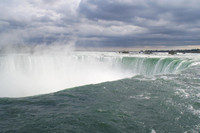
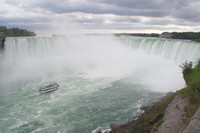
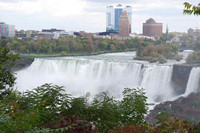
Left: you can see the lip of the Horseshoe Falls (the Canadian ones) from just above them.
Centre: the same falls from a little downstream with a tourist boat heading into the spray.
Right: the US town of Niagara Falls with the American Falls in the foreground.
 photos of Niagara and its waterfalls
photos of Niagara and its waterfalls
I followed the river northwards downstream, along with many other out-of-season tourists.
The Niagara river flows round a small island thus creating the two 55m-tall falls
– the Horseshoe Falls are almost 800m around, while the American Falls are 320m across.
An enormous volume of water flowing and crashing from Lake Erie down to Lake Ontario.
And thence, through a maze of grim industrial wastelands and posh garden-landscaped suburbs,
I returned to the airport, the road signs being, as usual, less helpful than
those in Europe.
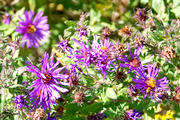 bright flowers
bright flowers
 egret flying to fishing stance
egret flying to fishing stance
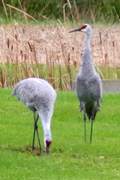 sandhill cranes
sandhill cranes
 grey squirrel
grey squirrel
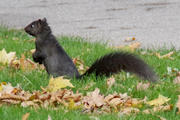 black squirrel
black squirrel
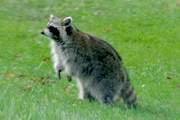 raccoon
raccoon
 unconcerned fox
unconcerned fox
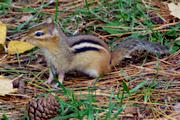 chipmunk
chipmunk